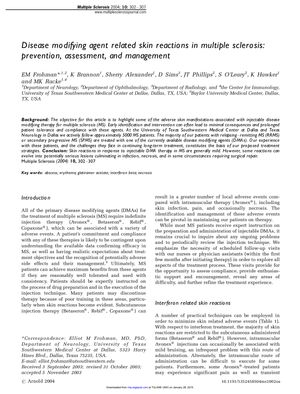Disease Modifying Agent Related Skin Reactions in Multiple Sclerosis: Prevention, Assessment, and Management
May 2004
in “
Multiple Sclerosis Journal
”

TLDR The article concludes that proper injection techniques and patient education can prevent serious skin reactions from multiple sclerosis medications.
The 2004 article discusses skin reactions to injectable disease modifying agents (DMAs) for multiple sclerosis (MS), based on experience with approximately 5000 patients. It concludes that while most skin reactions are mild, serious complications like infection and necrosis can occur, with about 5% of patients treated with Betaseron® experiencing skin necrosis. Factors such as poor injection technique, inadequate skin cleaning, and smoking may increase the risk of adverse reactions. Recommendations for prevention include patient education on proper injection techniques, rotating injection sites, and follow-up visits. Practical advice to minimize pain and reactions includes warming medication, using shorter needles for lean patients, and applying topical anesthetics or ice. The document also suggests that autoinjectors and prefilled products might improve compliance and reduce skin reactions, and emphasizes the importance of a 'site map' for tracking injection sites. It is crucial for healthcare providers and patients to be aware of potential skin complications and their management when using injectable MS therapies.




